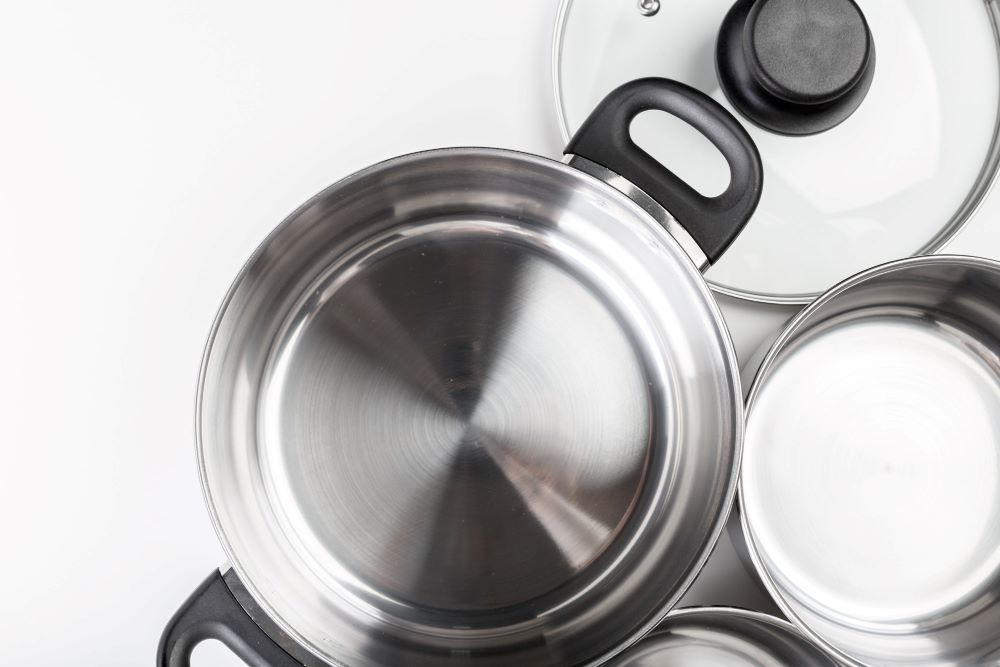
Imagine a busy professional kitchen, where pots and pans clatter and flames dance from the gas burners. In the middle of all this culinary chaos, one thing stands out: the shiny gleam of stainless steel cookware. But why do chefs swear by these sleek silver tools? Let’s explore the science behind why stainless steel is the kitchen’s favorite choice.
Stainless steel handles heat and why it’s perfect for cooking
Stainless steel itself isn’t the best heat conductor. However, most high-quality stainless steel cookware features a multi-ply construction, often with an aluminum or copper core. This clever design marries the durability of stainless steel with the superior heat conductivity of these metals.
The result? A pan that heats evenly and responds quickly to temperature changes. No more hot spots burning your delicate sauces or unevenly cooked steaks. It’s like having a precision instrument at your fingertips, allowing for the kind of temperature control that makes culinary magic happen.
Stainless steel’s strength and why it lasts so long
Stainless steel cookware is an alloy, primarily made of iron, chromium, and nickel. The chromium forms a thin, invisible layer of chromium oxide on the surface, which acts like a force field against corrosion and rust.
This molecular armor means your stainless steel cookware can go from stovetop to oven, withstand high heat, and survive the occasional drop without a scratch. It’s the kitchen equivalent of a superhero – virtually indestructible.
The Non-Reactive Nature of Stainless Steel
Ever noticed how tomato sauce tastes metallic when cooked in certain pans? Not with stainless steel! Its non-reactive properties make it a chef’s best friend when working with acidic ingredients.
The chromium in stainless steel forms a passive layer that prevents the metal from interacting with food. This means you can simmer your tangy tomato sauces, deglaze with wine, or whip up a lemon curd without fear of metallic flavors or discoloration.
It’s like having a neutral canvas that lets the true flavors of your ingredients shine through. No wonder chefs consider it essential for preserving the integrity of their culinary creations.
The Science of Easy Maintenance
After a long day in the kitchen, the last thing a chef wants is a battle with stubborn food residue. Stainless steel’s smooth, non-porous surface makes cleanup a breeze.
The science behind this ease of maintenance lies in stainless steel’s lack of microscopic crevices where food particles can hide. Unlike cast iron or copper, which can develop patinas or require special care, stainless steel maintains its sleek surface with simple soap and water.
This low-maintenance nature not only saves time but also ensures hygienic cooking conditions – crucial in professional kitchens where cleanliness is paramount.
The Versatility of Stainless Steel
From searing to sautéing, braising to boiling, stainless steel cookware does it all. But what makes it so adaptable?
The answer lies in its ability to withstand extreme temperatures without warping or leaching chemicals. This temperature resilience, combined with its excellent heat distribution, means a single stainless steel cookware can handle a variety of cooking techniques.
Imagine searing a steak on high heat, then deglazing the pan with wine for a rich sauce, all without changing cookware. It’s this versatility that makes stainless steel a space-saving, efficient choice in both professional and home kitchens.
How Stainless Steel Stacks Up
While stainless steel is a kitchen favorite for its durability and versatility, it’s worth comparing it to other materials like cast iron and non-stick cookware. Each material has its strengths, but stainless steel stands out for its ability to handle high heat, resist corrosion, and provide even cooking. Let’s compare the following:
Cast Iron: The Heavy Hitter
- Pros: Excellent heat retention, naturally non-stick when seasoned
- Cons: Heavy, requires special maintenance, can react with acidic foods
- Verdict: Great for specific tasks, but lacks the versatility of stainless steel
Non-Stick: The Slippery Slope
- Pros: Easy to clean, requires less oil for cooking
- Cons: Can’t withstand high heat, coating can scratch or degrade over time
- Verdict: Convenient for certain dishes, but not as durable or versatile as stainless steel
Copper: The Conductor
- Pros: Superior heat conductivity, beautiful appearance
- Cons: Expensive, requires regular polishing, can react with acidic foods
- Verdict: Excellent for specific cooking tasks, but lacks the practicality and durability of stainless steel
Why Chefs Choose Stainless Steel
In the end, it’s the perfect storm of scientific properties that makes stainless steel the go-to choice for professional chefs:
- Even heat distribution for precise cooking
- Durability to withstand the rigors of a busy kitchen
- Non-reactive nature for versatile ingredient use
- Easy maintenance for efficient cleaning
- Versatility to handle various cooking techniques
It’s not just cookware; it’s a reliable partner in culinary creation. So the next time you see a chef confidently wielding a stainless steel pan, you’ll know the science behind their choice. In conclusion, the science behind chefs’ love for stainless steel cookware comes down to its exceptional heat distribution, strength, and resistance to damage.
With its ability to withstand high temperatures, last for years, and deliver reliable cooking results, stainless steel remains a top choice in both professional kitchens and home cooking spaces. If you’re a seasoned chef or a home cook, it’s clear why stainless steel remains the top choice for cooking excellence.
Ready to elevate your cooking game? Explore our range of professional-grade stainless steel cookware and cook like the pros!






